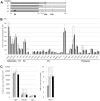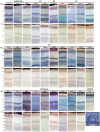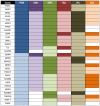mRNA expression analysis of the SUMO pathway genes in the adult mouse retina
- PMID: 25617419
- PMCID: PMC4365491
- DOI: 10.1242/bio.201410645
mRNA expression analysis of the SUMO pathway genes in the adult mouse retina
Abstract
Sumoylation is a reversible post-translational modification that regulates different cellular processes by conjugation/deconjugation of SUMO moieties to target proteins. Most work on the functional relevance of SUMO has focused on cell cycle, DNA repair and cancer in cultured cells, but data on the inter-dependence of separate components of the SUMO pathway in highly specialized tissues, such as the retina, is still scanty. Nonetheless, several retinal transcription factors (TFs) relevant for cone and rod fate, as well as some circadian rhythm regulators, are regulated by sumoylation. Here we present a comprehensive survey of SUMO pathway gene expression in the murine retina by quantitative RT-PCR and in situ hybridization (ISH). The mRNA expression levels were quantified in retinas obtained under four different light/dark conditions, revealing distinct levels of gene expression. In addition, a SUMO pathway retinal gene atlas based on the mRNA expression pattern was drawn. Although most genes are ubiquitously expressed, some patterns could be defined in a first step to determine its biological significance and interdependence. The wide expression of the SUMO pathway genes, the transcriptional response under several light/dark conditions, and the diversity of expression patterns in different cell layers clearly support sumoylation as a relevant post-translational modification in the retina. This expression atlas intends to be a reference framework for retinal researchers and to depict a more comprehensive view of the SUMO-regulated processes in the retina.
Keywords: In situ hybridization; SUMO; light cycle; mRNA expression levels; retina; sumoylation.
© 2015. Published by The Company of Biologists Ltd.
Conflict of interest statement
Figures





Similar articles
-
SUMO E3 ligases are expressed in the retina and regulate SUMOylation of the metabotropic glutamate receptor 8b.Biochem J. 2011 Apr 15;435(2):365-71. doi: 10.1042/BJ20101854. Biochem J. 2011. PMID: 21288202
-
Cell cycle-dependent conjugation of endogenous BRCA1 protein with SUMO-2/3.Biochim Biophys Acta. 2011 Apr;1810(4):432-8. doi: 10.1016/j.bbagen.2010.12.001. Epub 2010 Dec 13. Biochim Biophys Acta. 2011. PMID: 21147198
-
The Sumo protease Senp7 is required for proper neuronal differentiation.Biochim Biophys Acta. 2016 Jul;1863(7 Pt A):1490-8. doi: 10.1016/j.bbamcr.2016.03.028. Epub 2016 Mar 31. Biochim Biophys Acta. 2016. PMID: 27039038
-
Emerging roles of desumoylating enzymes.Biochim Biophys Acta. 2009 Mar;1792(3):155-62. doi: 10.1016/j.bbadis.2008.12.008. Biochim Biophys Acta. 2009. PMID: 19162180 Review.
-
SUMOylation in carcinogenesis.Cancer Lett. 2012 Mar 28;316(2):113-25. doi: 10.1016/j.canlet.2011.10.036. Epub 2011 Nov 2. Cancer Lett. 2012. PMID: 22138131 Review.
Cited by
-
Retinal ganglion cell loss in an ex vivo mouse model of optic nerve cut is prevented by curcumin treatment.Cell Death Discov. 2021 Dec 15;7(1):394. doi: 10.1038/s41420-021-00760-1. Cell Death Discov. 2021. PMID: 34911931 Free PMC article.
-
Pias3 is necessary for dorso-ventral patterning and visual response of retinal cones but is not required for rod photoreceptor differentiation.Biol Open. 2017 Jun 15;6(6):881-890. doi: 10.1242/bio.024679. Biol Open. 2017. PMID: 28495965 Free PMC article.
-
Expression Atlas of the Deubiquitinating Enzymes in the Adult Mouse Retina, Their Evolutionary Diversification and Phenotypic Roles.PLoS One. 2016 Mar 2;11(3):e0150364. doi: 10.1371/journal.pone.0150364. eCollection 2016. PLoS One. 2016. PMID: 26934049 Free PMC article.
-
The tumor-associated YB-1 protein: new player in the circadian control of cell proliferation.Oncotarget. 2017 Jan 24;8(4):6193-6205. doi: 10.18632/oncotarget.14051. Oncotarget. 2017. PMID: 28008157 Free PMC article.
References
-
- Chakarova C. F., Papaioannou M. G., Khanna H., Lopez I., Waseem N., Shah A., Theis T., Friedman J., Maubaret C., Bujakowska K. et al. (2007). Mutations in TOPORS cause autosomal dominant retinitis pigmentosa with perivascular retinal pigment epithelium atrophy. Am. J. Hum. Genet. 81, 1098–1103. 10.1086/521953 - DOI - PMC - PubMed
LinkOut - more resources
Full Text Sources
Other Literature Sources
Molecular Biology Databases

